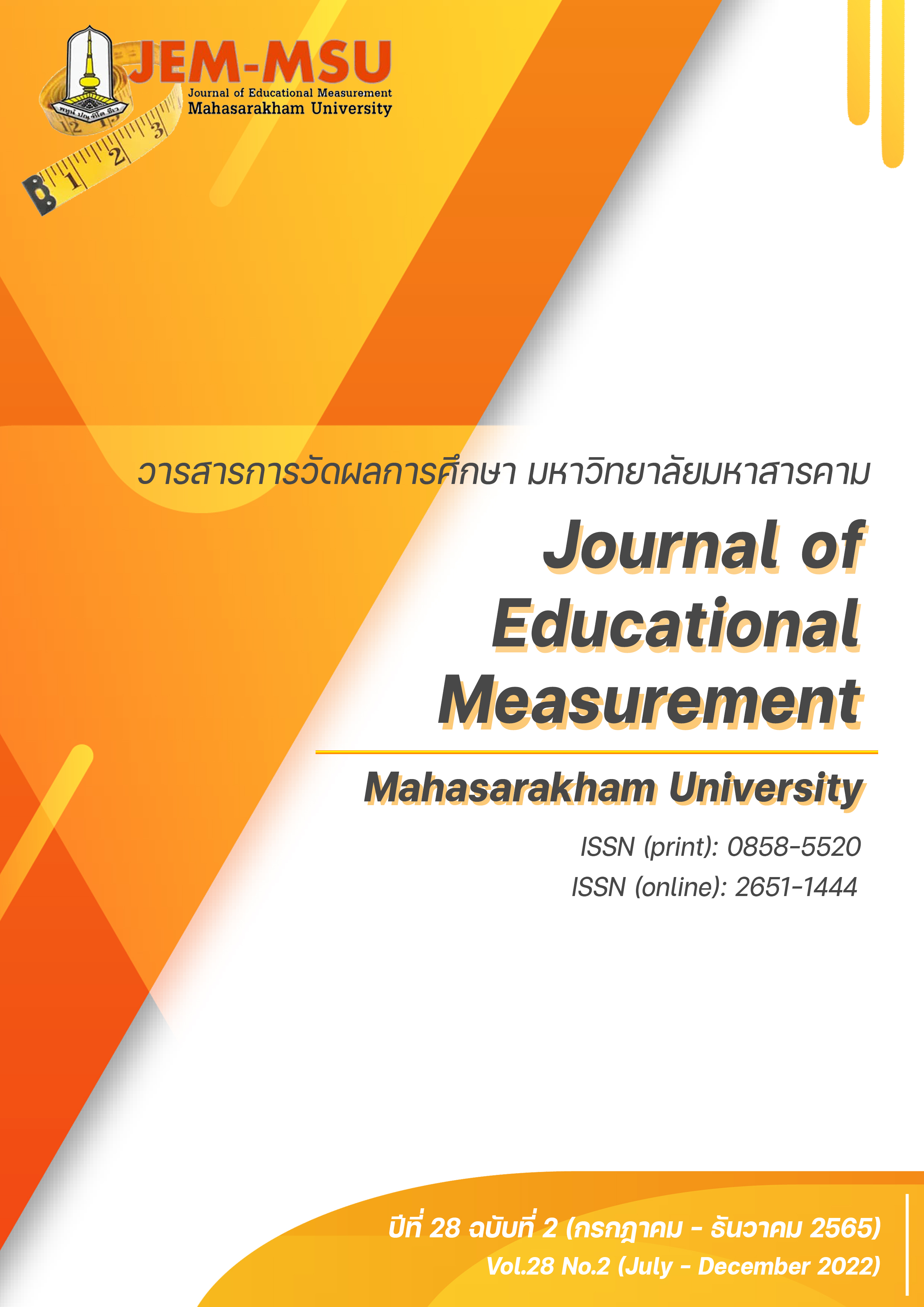Psychological Attribute Measurement Scales
Main Article Content
Abstract
A psychological attribute measurement scale is a tool used to indirectly assess abstract intrinsic qualities of individuals. Lord & Novick (1958) and Torgerson (1958) define measurement as a process that assigns a value to the attributes or qualities of an object or event. Therefore, a person who wants to measure such attributes needs to develop a tool that has good psychometric properties to ensure the reliability of the results. The objectives of this article were to review the content of the concepts of measuring individual’s intrinsic psychological attributes, different types of psychological attribute scales, development of each type of psychological scales, which has a different process and a different method of implementation. For example, the Thurstone Scale is used to measure only one attribute by indicating the magnitude of the attribute or variable in consecutive scores. The Guttman Scale is a scale that focuses on measuring each aspect of a person's attitude and brings together all the surveyed data. This scale tells us the overall opinion of a person on all aspects of a certain thing. The Likert Scale is a scale using questions, which can be either positive or negative, to measure how the respondents feel about the measurement target. The Osgood Scale uses the meaning of language to measure various concepts. Adjectives are used in the scales because they can be used with both positive and negative meanings. The article also presents a brief review on psychological attribute measurement scales in the new normal situation.
Article Details

This work is licensed under a Creative Commons Attribution-NonCommercial-NoDerivatives 4.0 International License.
The content and information contained in the published article in the Journal of Educational Measurement Mahasarakham University represent the opinions and responsibilities of the authors directly. The editorial board of the journal is not necessarily in agreement with or responsible for any of the content.
The articles, data, content, images, etc. that have been published in the Journal of Educational Measurement Mahasarakham University are copyrighted by the journal. If any individual or organization wishes to reproduce or perform any actions involving the entirety or any part of the content, they must obtain written permission from the Journal of Educational Measurement Mahasarakham University.
References
Barak, A. (2011). Internet-based psychological testing and assessment. In R. Kraus, J. S. Zack, &
Speyer, C. (Eds.), Online counseling: A handbook for mental health professionals. 2nd Ed. (pp. 225-255). Elsevier Science.
Butler, J., & Kern, M. L. (2016). The PERMA-Profiler: A brief multidimensional measure of flourishing. International Journal of Wellbeing, 6(3), 1-48.
Groth-Marnat, G. (2009). Handbook of psychological assessment (5th ed). Wiley.
Kidder LH, Judd C, Eliot R. (1986). Research methods in social relations. Holt, Rinehart & Winston.
Lord, Frederic M. and Novick, Melvin R. (1958). Statistical Theories of Mental Test Scores. Addison-Wesley.
Maheu, M. M., & Gordon, B. L. (2000). Counseling and therapy on the Internet. Professional Psychology: Research and Practice, 31,484–489.
Naus, M. J., Philipp, L. M., & Samsi,M. (2009). From paper to pixels: A comparison of paper and computer formats in psychological assessment. Computers in Human Behavior, 25(1). 1-7.
McLellan, L.F., Kangas, M., Rapee, R. M., Iverach, L., Wuthrich, V. M., Hudson, J. L. & Lyneham, H. J. (2020). The Youth Online Diagnostic Assessment (YODA): Validity of a New Tool to Assess Anxiety Disorders in Youth. Child Psychiatry & Human Development, 52, 270–280.
Miller, E. T., Neal, D. J., Roberts, L. J., Baer, J. S., Cressler, S. O., & Metrik, J., et al. (2002). Test-retest reliability of alcohol measures: Is there a difference between Internet-based assessment and traditional methods?. Psychology of Addictive Behaviors, 16, 56-63.
Pearson. (October, 2021). Wechsler Adult Intelligence Scale - Fourth UK Edition (WAIS-IV UK) – Telepractice and WAIS-IV. https://www.pearsonclinical.co.uk/Psychology/AdultCognitionNeuropsychologyandLanguage/AdultGeneralAbilities/WechslerAdultIntelligenceScale-FourthUKEdition(WAIS-IVUK)/ForThisProduct/telepractice-wais-iv.aspx
Rammstedt, B., Holzinger, B., & Rammsayer, T. (2004) Comparison of paper-and-pencil vs. computerized administration of the NEO-Five Factor Inventory (NEO-FFI). Diagnostica, 50, 88-97
Seligman, M. E. P. (2011). Flourish: A visionary new understanding of happiness and well-being. Free Press.
Torgerson, W. S. (1958). Theory and methods of scaling. John Wiley.
VandenBos, G. R., & Williams, S. (2000). The Internet versus the telephone: What is telehealth, anyway? Professional Psychology: Research and Practice, 31, 490–492.
Kanjanawasee, S. (2001). Measuring and Evaluating Thinking Abilities, Thinking Science. Institute of Academic Development Press. (in Thai).
Laothong, N. (2013). Conducting Educational Research Tools. Chulalongkorn University Press. (in Thai)
Pothisan, P. (2020). Guttman Scaling. Encyclopedia of Education. http://ejournals.swu.ac.th/index.php/ENEDU/article/view/5701/5339. (in Thai)
Saengkaew, P. (1998). Social Science Research (3rd ed.). Thammasat University Press. (in Thai)
Saiyos, L. and Saiyos, A. (1985). Educational Research Principles. Suksaporn Press. (in Thai)
Srisa-ard B. (2013). Basic Research (9th ed.). Suweeriyasan. (in Thai)
Worakham, P. (2019). Educational Research (10th Ed). Taksila Karnpim. (in Thai)


